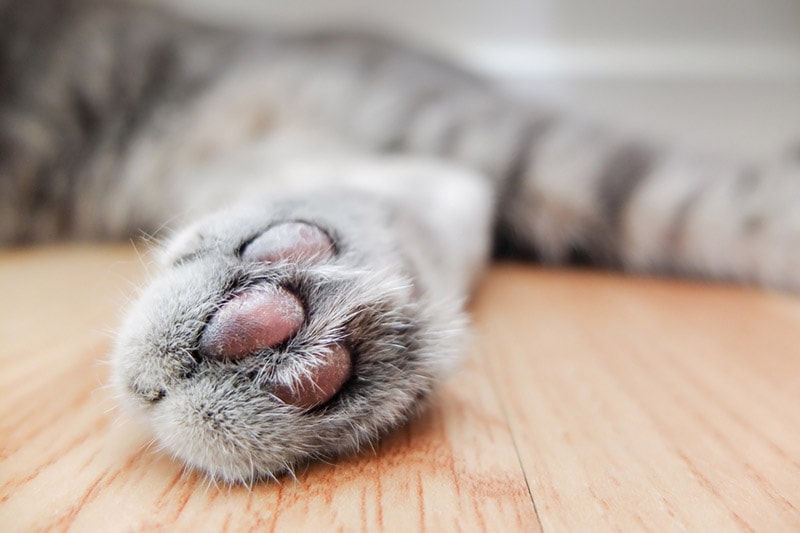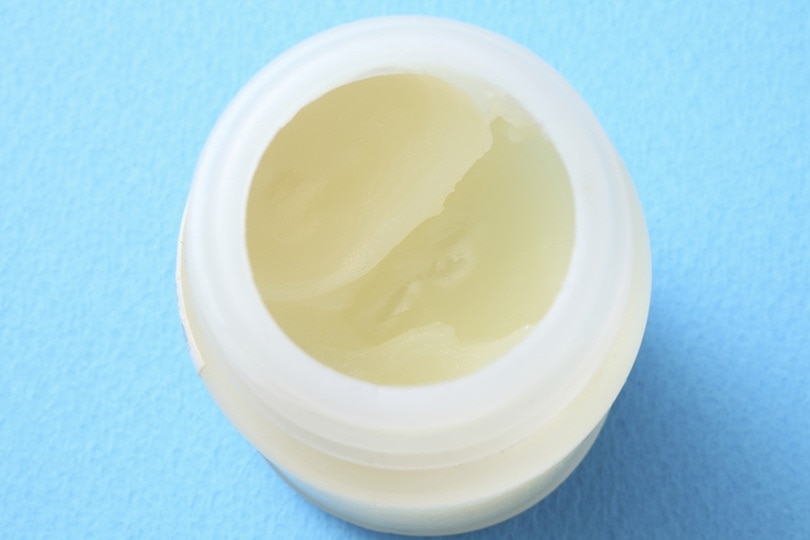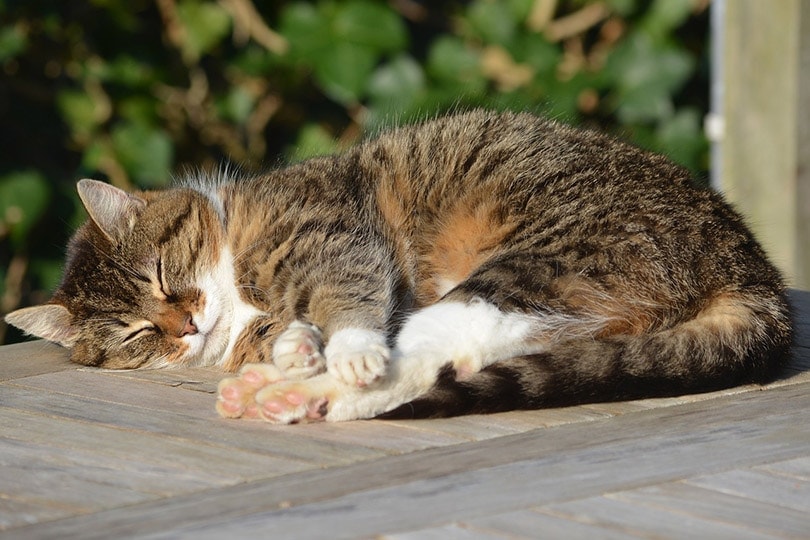Can I Put Vaseline on My Cat’s Paws? Our Vet Discusses Safety, Application & More
By Dr. Luqman Javed, DVM (Vet)
Updated on

Vaseline is a type of petroleum jelly. Its main purpose is to act as a moisture barrier on skin, and therefore it is commonly used for conditions involving dry skin in humans. Cats may, on occasion, develop dry or cracked paws, a condition that is generally painful. You might be wondering if using Vaseline on your cat in such a scenario is safe.
The answer is yes, Vaseline is safe for a cat’s paws when used externally – this implies that you ensure that your cat doesn’t lick it all off. If your cat consumes a small amount of Vaseline, it shouldn’t be a major issue. However, Vaseline has no nutritional benefits for your cat, so you shouldn’t try to feed your cat Vaseline.
Is Vaseline Safe to Put on My Cat’s Paws?
Vaseline is made up of mineral oils and waxes and is considered safe for your cat’s paws. Original Vaseline® is the best choice for your feline companion. When used on a cat’s paws, it will function similarly to how it works on humans – it will create a moisture barrier that will moisturize, soothe, and provide relief for dry or cracked paws.

Applying Vaseline to Your Cat’s Paws
When applying Vaseline to a cat’s paws, it is best to use a minimal approach. Gently massage a very small amount onto your cat’s paw pads. Because a cat’s paws are considered somewhat sensitive, some cats may not like having them touched. To circumvent this issue, you can try a distraction, such as a lick mat, or have someone else gently pet and talk to the cat while you apply the Vaseline.
Your cat might shake or flick its paw to remove the Vaseline from their feet. If your cat does so, and you notice Vaseline coming off, it is an indication that you might have applied too much. The sensitive nature of your cat’s paws might result in your cat attempting to lick the Vaseline off them shortly after application.
Fortunately, Vaseline ingested in small amounts isn’t considered toxic. However, if you notice your cat habitually doing this, you should try to find a way to circumvent this issue. An Elizabethan collar, also known as an e-collar or a “donut” collar, is a great fix in such a situation.
It’s also important to have your cat looked over by a veterinarian for their cracked paws.
Causes of Dry or Cracked Paws
A cat’s paws are used for many reasons, which include walking, running, jumping, self-grooming, digging, scent marking, sweating, and catching prey. Cracked paws are never considered normal and are often a result of dry air, cold weather, excessive grooming, contact with an inappropriate surface, or an underlying issue or illness.
Signs of Dry or Cracked Paws
It can sometimes be tricky to determine whether your cat’s paws are dry or cracked. As both dryness and cracks in paws are painful, the signs you would most likely notice would be associated with your cat’s movement habits.
- Your cat walks and runs less often
- Your cat limps
- Your cat no longer jumps up to their favorite spots
- Your cat is excessively licking their paws
- Your cat refuses to cover their waste in the litter box
- Your cat grooms their body less and focuses more on just licking their paws
- Your cat yowls in pain when their paws are touched
If you notice these signs in your cat, you should have your cat examined by your vet.
Additional Remedies For Cracked Paws
If your cat frequently develops cracked paws as the weather turns, it might be a good idea to provide them with extra care. Vaseline is great, but there are other remedies you can use as well. These include the following:
- Hydration – keeping your cat well hydrated will reduce the odds of dry or cracked paws. In addition, hydration is also important in the recovery process if your cat already has cracked paws. Encourage your cats to drink more water by providing a water fountain or using pet broths with their food.
- Socks and Pet Shoes – like how you would cover your heels in cold weather, you can consider protecting your cat’s paws with pet-sized socks or boots. Take note that not all cats readily accept these. If they seem to cause your cat a great deal of stress or discomfort, these might not be ideal for your cat.
- Oils – oil supplements that are cat-safe are a fantastic aid when it comes to issues like dry or cracked paws. These include fish oil and coconut oil. Coconut oil can also be used externally as an alternative to Vaseline for application on your cat’s paws. It is important to note that while certain oils are good for cats, you should NEVER use essential oils of any kind to treat cracked paws or any other ailment in cats.
- Moisturizers for Cats – if Vaseline or other remedies available at home aren’t doing the trick, ask your vet for a moisturizer made specifically for cat paws. These are designed specifically for your cat and might help if other remedies just don’t seem to work.
- Monitor Your Cat’s Movements – your cat might be developing problems with their paws if they come in contact with a surface that irritates the paws. A good remedy is to keep your cat indoors and in an area where you can ensure they aren’t stepping on a surface that could be irritating their paws. Remember that certain floor cleaners and detergents can be an irritant for your cat’s paws and skin. If you suspect this to be the case, try switching to pet-safe cleaners and detergents.
 Conclusion
Conclusion
Dry and cracked paws are an uncomfortable, painful condition that warrants veterinary care. Vaseline is a moisturizer that is non-toxic and can provide moisturization and pain relief for your cat’s dry paw woes. You can try using it as a remedy to help your cat while they recover. Although it has no nutritional value and shouldn’t be fed to cats, small amounts that your cat might ingest by licking shouldn’t be cause for alarm.
Featured Image Credit: patthamapong, Shutterstock












